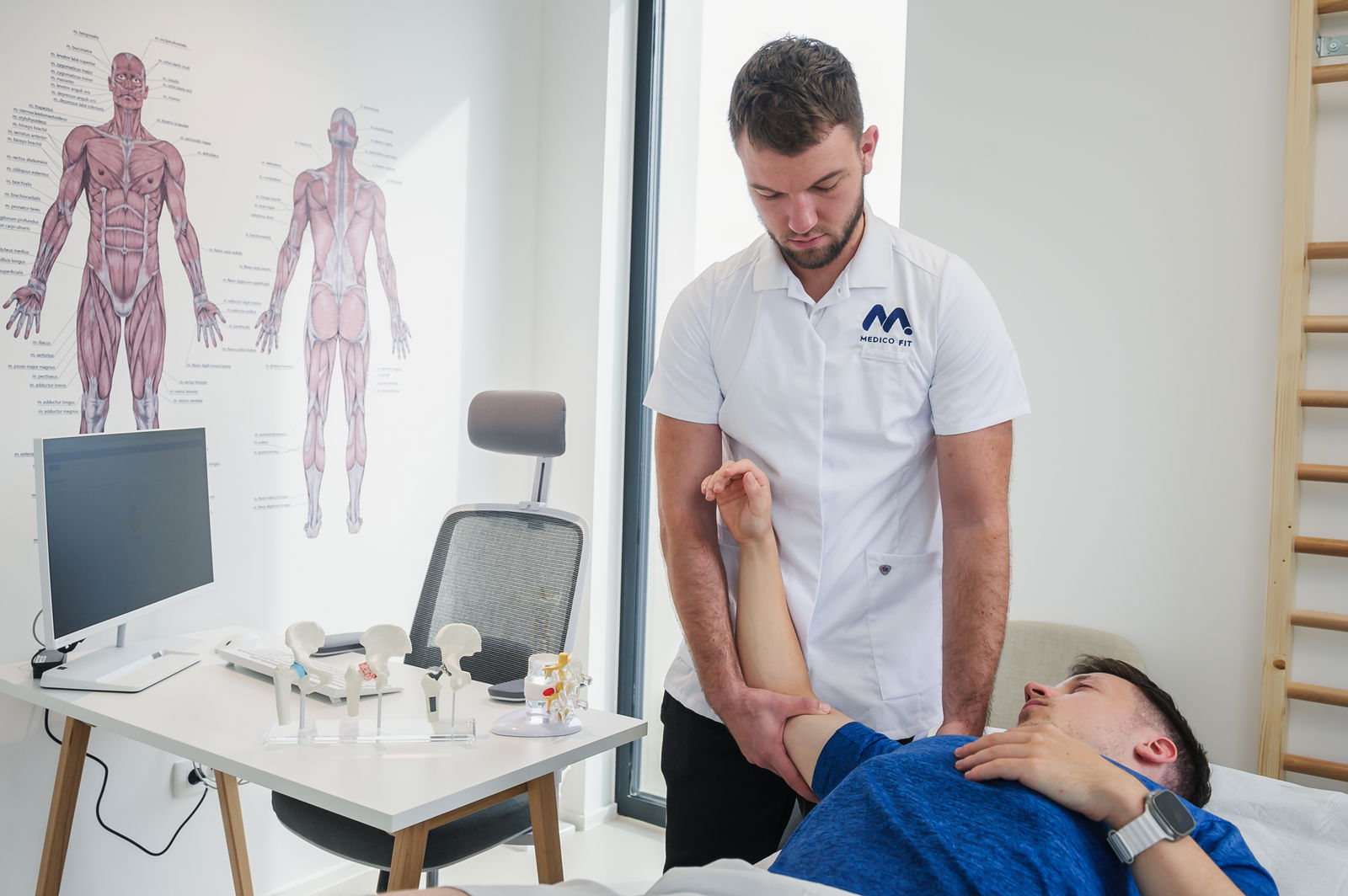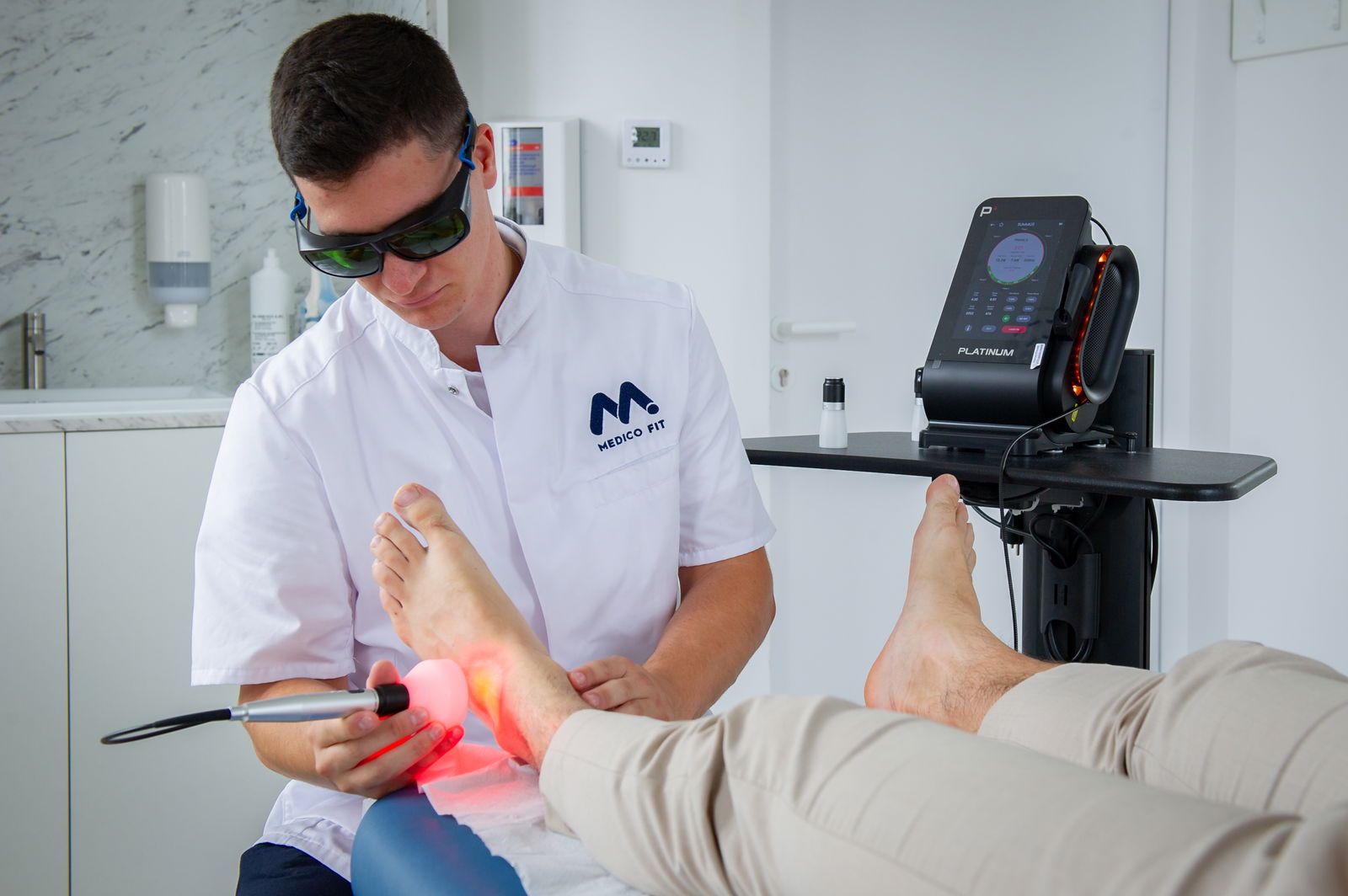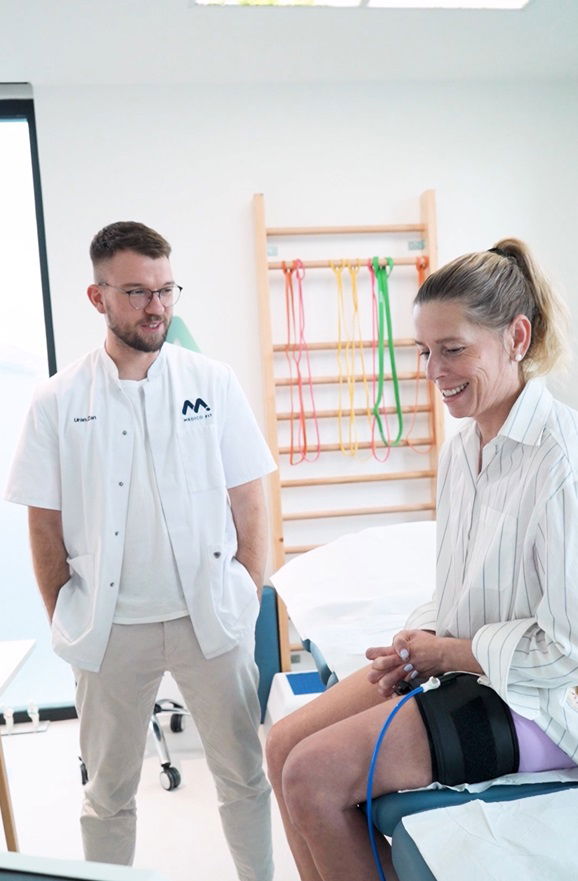In recent years, it seems that physiotherapy in Slovenia is no longer working. Long waiting times are only one of the superficial problems that are most evident to the laymen, but they are far from the only one that has a negative impact on patients today.
With this article, MEDICOFIT physiotherapy specialists raise awareness among readers about the right decisions when choosing physiotherapy, and, above all, they introduce the professional side of the current state and developments in the field of physiotherapy in Slovenia. For the first time, readers will gain a rarely-accessible insight into the background of the profession, with the aim of being able to make the right decisions regarding treatment for musculoskeletal problems.
Since our basic freedom of life is ensured by unrestricted movement, and at the same time, public healthcare no longer provides appropriate physiotherapy solutions, it is important for the reader to be aware of the responsibility they bear when choosing a private provider.
Waiting times for physiotherapy
Many patients are dissatisfied with physiotherapy treatment within the framework of prescriptions, as their problems are not resolved. As a result, for several years now, we have been observing the death spiral effect within physiotherapy in Slovenia, which in theory means that when a certain cascade of events begins, they can no longer be stopped, leading to a collapse in their final form.
Book a physiotherapy appointment

Because of long waiting times, physiotherapy is conducted with increasingly accelerated routine solutions that are not tailored to the patient’s condition, and as a result, a growing number of patients is returning to the waiting list with the same problems. This is just one aspect of the collapse of current physiotherapy, and the problem is further exacerbated by general trends of diseases, with musculoskeletal conditions on the rise and currently representing one of the fastest growing segments of healthcare, with chronic age-related diseases in particular having a steep curve.
All of this means that the majority of waiting times nowadays have already exceeded the point where performing physiotherapy even makes sense, at least from an expert perspective, and most actual therapies are steadily declining in quality. In other words, the average patient has been waiting so long for physiotherapy treatment nowadays that the treatment protocols themselves are questionable.
The perspective of wanting to use the healthcare services that we are entitled to is, of course, generally present and understood, but it also leads to numerous wrong decisions with health consequences for the patient, which are increasingly common today. Most often, the patient has no choice but to come to terms with, to a greater or lesser extent, permanent problems due to the primary injury or disease for which they required physiotherapy.
How long a waiting period is acceptable?
With the exception of certain conditions that have clear contraindications, starting physiotherapy is always recommended as soon as possible, or early in the acute phase.
Physiotherapy after surgery
Latest guidelines for physiotherapy after surgery, or for postoperative physiotherapy, recommend starting specialised acute therapy within 1–3 days after discharge from the hospital to ensure an optimal rehabilitation window.
The optimal rehabilitation window represents the period in which therapy has the greatest effect and at the same time the acceptable time frames within which we achieve the goals of each phase of rehabilitation. Here we should note that these are not just recommendations, but a scientifically well researched process, where we know for each joint surgery exactly how to carry out the treatment procedures in terms of timing.
At MEDICOFIT clinic, the phenomenon of delayed rehabilitation is often observed, which occurs when patients start physiotherapy several weeks or months later than recommended. The reason is that patients often choose private healthcare services as secondary, meaning that the average private physiotherapy expert only gets the opportunity to provide therapy when the rehabilitation is already in a delayed phase or is drastically worse than expected.
Early physiotherapy after surgery will reduce weakness and a lesser decline in the patient’s physical abilities in the remaining areas of the body, and will also accelerate healing. The longer we delay the start of physiotherapy, the greater the functional deficit that will occur in the area itself. The greater the loss of joint mobility and muscle strength, the more difficult it will be to regain lost mobility during the rehabilitation process.
Physiotherapy in case of chronic pain?
In the case of chronic pain, it is recommended to start physiotherapy before the pain becomes chronic. The patient should visit a physiotherapy specialist for the joint area if pain occurs without injury, persists for at least 3 days, and does not decrease in intensity.
The sooner we start treating the pain itself, the less likely that the pain will become chronic. However, if the pain is already chronic in nature, quick action is even more important.
It is important to note that in the case of chronic pain, physiotherapy on prescription provides general treatment, which will not bring the desired lasting effects for most patients, and many private providers are merely an extension of the same general practice, which means that the patient must carefully check whether they will be treated with specialist physiotherapy for chronic problems.
The longer the pain persists in the case of chronic problems, the more important it is to conduct a comprehensive assessment of the patient’s general condition and to take into account other factors that are not necessarily solely related to the injured segment.
Book a physiotherapy appointment

How long is too long and risky to wait to start physiotherapy after surgery?
The longer we wait after three days of surgery, the greater the risk of permanent movement limitations. If we wait too long to mobilise the operated area, the soft tissue structures around the operated segment adapt to the new, smaller range of motion that the patient is using at that moment, which leads to resulting anatomical shortening of the muscles, tendons, and ligaments.
The above-described process of shortening of soft tissue structures leads to various contractures, which are more difficult to resolve during the rehabilitation process itself. Often, waiting too long leads to a greater decline in muscle strength and muscle mass, i.e. a process of postoperative atrophy.
The greater the muscle deficit, the lower the load-bearing capacity of the joint, which means that the rehabilitation process will take longer to restore the recommended safe load-bearing capacity.
Most patients who start rehabilitation after surgery too late are not faced with an unsuccessful acute phase so much as with various deficits that remain from the middle and late phases of rehabilitation, which puts the patient at high risk of rapid re-injury.
What are the most common mistakes patients make when waiting for physiotherapy?
Common mistakes patients make while waiting for physiotherapy after surgery can be divided into two groups.
Immobility after surgery
The first group of patients is the one who is completely immobile after surgery, which means that they do nothing and consequently lose functional abilities in the area of the surgery, as well as in parts of the body that were not affected by the operation.
At MEDICOFIT clinic, we advise each patient and prepare a rehabilitation protocol that reduces the loss of local and wider function. Such treatment is especially important for all patients who engage in sports recreationally or professionally, or for patients who are physically active.
We always recommend to every patient to remain as active as possible within the limits allowed by the surgery.
Inappropriate rehabilitation
The second group of mistakes is the exact opposite: these are patients who perform early acute rehabilitation in their own regimen or who only do so with a physiotherapist who is not trained on the special requirements of the early postoperative phase, which often means premature mobilisation, premature loading, etc.
The group of scientifically borderline alternative medicine, such as osteopathy, manual medicine, chiropractors, massage therapists and some other forms, which may have good general effects but are by no means an appropriate form of therapy in the process of postoperative rehabilitation, is particularly problematic.
Book a physiotherapy appointment

In recent years, we often see a group of patients who perform early rehabilitation based on information obtained on social networks and the Internet. Unfortunately, we also treat patients who, due to inadequate treatment in the early phase, have developed irreversible unwanted changes in the tissue of the operated joint itself.
How does waiting too long manifest itself in the body’s physiological response to delayed rehabilitation?
Increased functional deficits are the ultimate form of unsuccessful rehabilitation due to delayed start. Because the goal of physiotherapy is to restore the patient’s mobility, the correct expert position that we advocate at MEDICOFIT clinic is that rehabilitation is unsuccessful if functional deficits are not eliminated.
The physiological response is initially manifested by a decrease in local innervation in the area of the operated joint, which the patient later notices as a reduced ability to independently activate certain muscle groups. Reduced activation subsequently leads to more extensive atrophy, which affects the entire kinetic chain of muscles in the body.
The ultimate form is a movement pattern that has visible biomechanical adaptations and compensatory patterns, which represent a more or less serious long-term risk to the patient.
Permanently reduced joint mobility, secondary chronic pain, scarring, and morphological changes are just some of the more evident consequences of delayed rehabilitation that can affect any patient who waits for treatment too long.
An often unaddressed problem of delayed rehabilitation is connective tissue fibrosis, which manifests as scarring in the patient’s ligaments and joint capsule, a problem that affects many patients, unfortunately more often patients who primarily receive treatment on prescription and patients who have had various episodes of unsuccessful physiotherapy treatments in the past.
Waiting for physiotherapy after knee surgery
A special case of the so-called “champions” in waiting too long are all patients who have undergone knee surgery. This is a field where early rehabilitation is of particular importance, as acute physiotherapy is absolutely indicated, and adherence to prescribed specialist protocols must be ensured for the entire rehabilitation period.
Patients who do not begin postoperative knee rehabilitation early enough often develop a condition called arthrofibrosis – fibrosis of the joint capsule, which may require additional surgery in the future, and the risk of early joint wear and tear and inadequate function of the joint surfaces also increases significantly. In this case, there are truly extensive long-term consequences due to delayed rehabilitation.

Reasons why physiotherapy on prescription is no longer effective
The primary problem with physiotherapy on prescription nowadays is that the waiting times for physiotherapy are too long, which means that a large percentage of patients will experience the consequences of waiting that were described in the first part of this article.
Long waiting period
Long waiting periods are the main culprit why a patient with severe acute pain or an acute injury that could be resolved relatively quickly has to wait for physiotherapy several months.
The pain becomes chronic, the rehabilitation time is longer, and the likelihood of permanent damage is increased. The group of patients for whom it is essential to start physiotherapy quickly is unfortunately growing; this includes patients for whom the start of physiotherapy is indicated after just three days of surgery.
Inappropriately prescribed physiotherapy
A secondary problem that is affects all patients is the insufficient scope of prescribed physiotherapy, which cannot meet the expert requirements of effective treatment. Most patients are prescribed between 5 and 10 physiotherapy treatments, usually arranged once a day or even every day.
This is an allocation that is not based on any expert basis, but is adapted exclusively to the goal of quickly shortening the waiting list; this means that a patient will receive treatment that does not provide the proven necessary time windows between therapies for the body’s most appropriate response to therapy.
Related content: Why do most physiotherapies not work? The pitfalls of “quick” physiotherapy
The prescribed treatment regimen itself does not fundamentally provide the conditions for successful treatment in 90% of patients and remains in effect even if the waiting period is shortened.
Book a physiotherapy appointment
It is important to note that most pathological conditions follow the natural course of the disease. Thinking that the natural course of the disease will adapt to the waiting list or the prescribed therapy regimen is pathologically or radically wrong and, unfortunately, present in a large percentage of patients who decide to undergo physiotherapy on prescription.
Modern physiotherapy must adapt to the natural course of the disease and follow expert guidelines for time regimens for maximum effect.
Physiotherapy that lacks scientific evidence
The third problem with physiotherapy on prescription is that it still uses methods that do not have solid scientific evidence about their effectiveness or are based on scientific evidence that has already been changed to a large degree based on modern studies.
The main therapy technique that is still performed within the framework of physiotherapy on subscription is electrotherapy in the form of therapeutic ultrasound and interferential current stimulation – nowadays, we already have many alternatives that have more evidence regarding their effectiveness and achieve pain reduction much faster.
The core therapeutic modalities in physiotherapy on prescription still follow outdated treatment protocols, which means that we cannot expect any substantial effect from the therapy itself.
General physiotherapy
The fourth and perhaps biggest problem with physiotherapy on prescription are the general treatment protocols that treat a specific anatomical region in exactly the same way for all patients. There are seven groups of joints in the human body, and in each group there are approximately 30 to 50 potential sources of pain and injury.
The standard of modern physiotherapy is specialist treatment for the actual pathology that is present, meaning that the treatment plan between two patients who experience pain in the same joint can differ greatly.
General treatment according to a routine protocol is a great disadvantage of prescription that will persist even with shorter waiting times, and represents a more or less distinct problem for the patient depending on the complexity of the problems they are facing.
You can find an in-depth answer in the article: The main differences between general and specialist physiotherapy: Which to choose?

How do we start physiotherapy at MEDICOFIT clinic?
At MEDICOFIT clinic, we begin the rehabilitation process with diagnostic therapy. This is an innovation in the field of physiotherapy in Slovenia, providing the patient with optimal conditions for expertise-based treatment after surgery, physiotherapy for chronic pain, and comprehensive non-operative rehabilitation.
As part of diagnostic therapy, we address all key factors of rehabilitation and provide the patient with main information about the start of rehabilitation and the treatment of the condition itself.
Since we have been performing diagnostic therapy for three years as of the time of writing the article, we can speak about its effectiveness from the pool of more than 10,000 patients who have undergone diagnostic therapy and comprehensive treatment of injuries at MEDICOFIT clinic.
We can confidently say that, as physiotherapy specialists, we were the first in many patient cases to address certain important rehabilitation factors that patients were not informed about by medical staff during their previous treatment.
MEDICOFIT clinic experts will often be the so-called “voice of justice” of the physiotherapy profession, meaning that they will inform the patient of the main facts regarding their condition, even though the information may be sensitive and not well received.
Diagnostic therapy allows us to obtain the maximum possible amount of data about the condition of the damaged segment itself and the adjacent segments that were affected as a result of the primary injury or disease. It allows us to explore possible forms of physiotherapy and potential risk factors that led to the patient’s injury or occurred as a result of surgery or previous injury.
With diagnostic therapy, we can confidently plan the timing aspects of rehabilitation, the therapeutic treatment itself, and the necessary treatment specifications that must be included in the treatment of the condition for which the patient is seeking therapy, especially the integration of various specialist physiotherapy protocols.

















